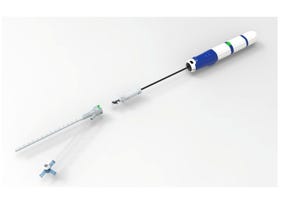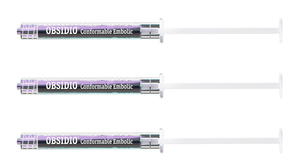May 27, 2007
Originally Published MPMN May 2007
ENGINEERING EXCELLENCE
Burr Hole Base Cap Supplies Security, Comfort for Neurological Procedure
Used in the treatment of movement disorders such as Parkinson’s disease, dystonia, and essential tremor, deep brain stimulation entails drilling a hole into a patient’s skull and inserting an electrical lead into it to a targeted area of the brain, which is then stimulated with electrical signals to alleviate symptoms. Lastly, the burr hole must be covered.
To perform the surgery, the patient’s head is numbed and immobilized through the use of a stereotactic head frame. Deeming the commonly used version of the head frame invasive, Image Guided Neurologics (IGN; Melbourne, FL; www.igneurologics.com) set out to create the Nexframe, a frameless version, to replace it. In the process of talking with neurosurgeons about the Nexframe, IGN discovered that the doctors were also unhappy with the cap currently used in the surgery to cover the burr hole after the lead was implanted—as were patients. After stumbling across this problem by accident, IGN was compelled to remedy it by developing StimLoc, an MDEA-winning sterile burr-hole cover.
“We identified very quickly that there was a product need both from the patient’s side and the physician’s side that needed to be addressed,” says Matthew Solar, vice president, engineering, for IGN.
Neurosurgeons complained that the existing cap was vulnerable to inadvertent lead dislodgment. This event could negate hours spent testing to find the “sweet spot” in the brain targeted for stimulation. And neurosurgeons weren’t the only ones disgruntled with the original design: Patients had to deal with the cosmetically undesirable protrusion from their skulls resulting from the large profile of the device.
Products implanted under the skin also can cause Twiddler’s syndrome in some patients, which is the repeated scratching of the device that potentially causes skin erosion or infection. This can be improved with a lower, more contoured profile, according to Solar.
Building on the current technique of plugging a stopper into a plastic piece, IGN modified the design to center on a base cap to cover the burr hole. The StimLoc features a base that mounts to the surface of the skull using two bone screws. After the lead is implanted and in the desired position, a secondary support clip snaps into the base and anchors the lead to prevent shifting. The lead is then folded over and a cap is snapped shut to further secure and protect the lead.
Physicians have confidence knowing that the lead will not dislodge, while patients profit from a contoured shape and low-profile design for a more comfortable and aesthetically pleasing device, Solar says. He maintains that the profile has been reduced by half from the original cap and is lower in profile than any other FDA-approved lead fixation device. Moreover, StimLoc enables repositioning, revision, or removal of the lead without causing damage.
“Medtronic (Minneapolis; www.medtronic.com) was the first company to have a product available for this market and they’re really the ones that invented the technology,” explains Solar. In an industry shrouded in nondisclosure and proprietary agreements, it is rare for a company to actually collaborate with an outside firm to improve upon a product—but that’s exactly what Medtronic did.
“They [Medtronic] were very open to helping us develop this product,” Solar says. “They helped us with identifying the proper materials to use that were compatible with the leads and supported us from a development standpoint all the way through the process. With that help, we were able to do it a lot more quickly than having to reinvent some of that stuff ourselves.”
IGN partnered with Vertex Technology LLC (St. Paul, MN) to design the components. Working together, IGN and Vertex developed the snap fits and the design for moldability of the extremely small and thin parts. Next, Reflex Medical Molding (White Bear Lake, MN; www.reflexmedical.com) was contracted to carry out the injection molding of the parts. Vertex collaborated with Reflex Medical to establish an approach that would allow the consistent running of parts and hold the tight tolerances necessary for the small snap features of the device, Solar says.
“We basically did all of the manufacturing part of it. They designed the part in-house, but we had some input on the tooling design,” says Tim Etters, chief operating officer of Reflex Medical. He adds that the precise tolerances and the need for maintaining consistent tolerances were challenges, but ones that were overcome.
After developing the StimLoc with input from Medtronic Neurological, IGN was acquired by Medtronic to complement its neurological device offerings, especially those for deep brain stimulation. Studies currently are being conducted that focus on using deep brain stimulation for treatment of additional neurological disorders such as depression, incontinence, and obsessive-compulsive disorder. If the studies yield positive results, there could be a significant expansion of applications in which the StimLoc is employed.
Copyright ©2007 Medical Product Manufacturing News
You May Also Like


